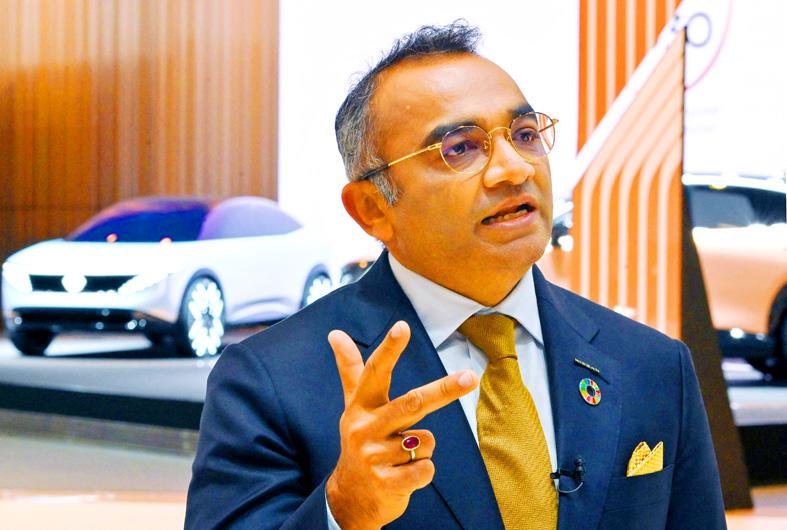Factory production in Japan in October edged up, ending a three-month slide and adding to signs that a global supply-chain crunch might have been easing before the emergence of the Omicron variant of SARS-CoV-2.
Higher output of vehicles and factory equipment lifted overall production 1.1 percent from September, the Japanese Ministry of Economy, Trade and Industry reported yesterday.
Manufacturers said that they plan to boost output again last month and this month, a good sign for Japan’s recovery this quarter.

Photo: AFP
Analysts had expected a 1.9 percent increase in October.
A separate report showed continued resilience in the labor market, with the unemployment rate ticking down to 2.7 percent and a measure of demand for workers showing positions on offer still outnumbering jobseekers.
While Japan’s manufacturing gains and positive production forecasts offer more evidence that Asia’s supply-chain shortages might be easing, the Omicron variant has reignited fears that a worst-case scenario could necessitate a return to growth-crippling lockdowns.
Japan yesterday closed its borders to new foreign arrivals, a move coming only weeks after the country managed to loosen restrictions amid plummeting case counts.
“If Omicron is found within Japan and triggers more restrictions, it could shift the recovery trajectory, but so far that doesn’t seem to be happening,” Itochu Research Institute economist Atsushi Takeda said. “September appears to have been the bottom for production.”
Bank of Japan Governor Haruhiko Kuroda on Monday said that he expects Japan’s economy to return to growth in the coming months, signaling that the emergence of Omicron had not changed his outlook much.
October’s production gain came as a shortage of parts from Asia began to ease and vehicle output increased for the first time in four months, a ministry official said.
Reports from Toyota Motor Corp showed that the group raised domestic output by about 22 percent in October, although the automaker’s global output is still down by more than one-quarter from last year’s level.
Manufacturers surveyed in yesterday’s report said that they plan to increase output by 9 percent last month and another 2.1 percent this month, but the reported plans tend to be overly optimistic and the survey was conducted before Omicron was discovered.
Semiconductor supplies also continue to be a problem.
Nissan Motor Co president Makoto Uchida said in an interview with Bloomberg Television this week that the company had expected to recover from shortages in the second half of the fiscal year, but he had become less optimistic.
The firm last month cut its sales plan for this year by 600,000 units due to continuing shortages.

To many, Tatu City on the outskirts of Nairobi looks like a success. The first city entirely built by a private company to be operational in east Africa, with about 25,000 people living and working there, it accounts for about two-thirds of all foreign investment in Kenya. Its low-tax status has attracted more than 100 businesses including Heineken, coffee brand Dormans, and the biggest call-center and cold-chain transport firms in the region. However, to some local politicians, Tatu City has looked more like a target for extortion. A parade of governors have demanded land worth millions of dollars in exchange

Hong Kong authorities ramped up sales of the local dollar as the greenback’s slide threatened the foreign-exchange peg. The Hong Kong Monetary Authority (HKMA) sold a record HK$60.5 billion (US$7.8 billion) of the city’s currency, according to an alert sent on its Bloomberg page yesterday in Asia, after it tested the upper end of its trading band. That added to the HK$56.1 billion of sales versus the greenback since Friday. The rapid intervention signals efforts from the city’s authorities to limit the local currency’s moves within its HK$7.75 to HK$7.85 per US dollar trading band. Heavy sales of the local dollar by

Taiwan Semiconductor Manufacturing Co’s (TSMC, 台積電) revenue jumped 48 percent last month, underscoring how electronics firms scrambled to acquire essential components before global tariffs took effect. The main chipmaker for Apple Inc and Nvidia Corp reported monthly sales of NT$349.6 billion (US$11.6 billion). That compares with the average analysts’ estimate for a 38 percent rise in second-quarter revenue. US President Donald Trump’s trade war is prompting economists to retool GDP forecasts worldwide, casting doubt over the outlook for everything from iPhone demand to computing and datacenter construction. However, TSMC — a barometer for global tech spending given its central role in the

An Indonesian animated movie is smashing regional box office records and could be set for wider success as it prepares to open beyond the Southeast Asian archipelago’s silver screens. Jumbo — a film based on the adventures of main character, Don, a large orphaned Indonesian boy facing bullying at school — last month became the highest-grossing Southeast Asian animated film, raking in more than US$8 million. Released at the end of March to coincide with the Eid holidays after the Islamic fasting month of Ramadan, the movie has hit 8 million ticket sales, the third-highest in Indonesian cinema history, Film